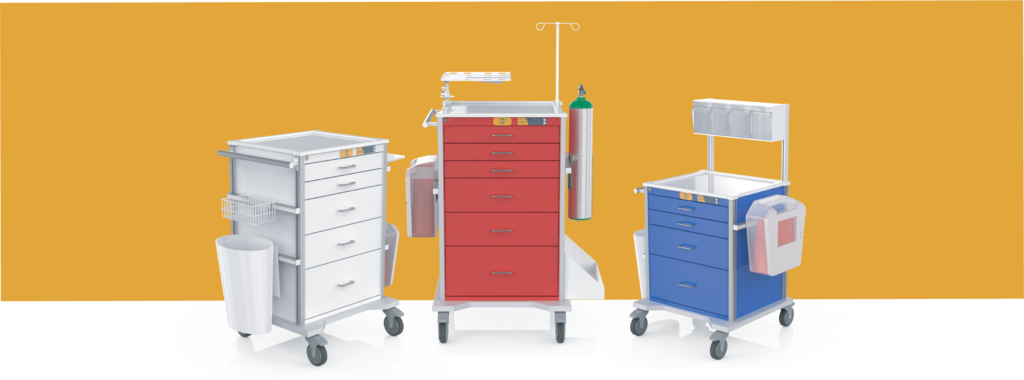Of the many potential uses of a procedure cart, few could be more important than the emergency crash cart. When a person’s heart stops, they need treatment immediately. If the cart for this situation is not properly designed and equipped, then there is no time to replace missing items. A patient may die. The right equipment is critical.
What is an emergency cart?
As the name suggests, emergency carts, also known as crash carts or code carts, are designed for the most severe medical emergencies, reflected by their red color. They contain the equipment necessary to conduct immediate lifesaving measures on someone who has stopped breathing or whose heart is no longer working. They may be found in an emergency room, another department of a hospital, a care home, or anywhere else where a patient may be at risk.
Equipment for a crash cart
1. Defibrillator
If a person needs to be resuscitated, one of the most obvious pieces of equipment you might need is a defibrillator. This administers an electric shock to the heart to try and restore it to its natural rhythm. Contrary to a common misconception, it is not used when a patient flatlines, but for dealing with certain forms of arrhythmia.
2. Intubation kit
Intubation can mean inserting any tube anywhere in the body, but in the context of cardiopulmonary resuscitation, it generally refers to tracheal intubation when the patient has trouble breathing and the tube is placed in the windpipe. This opens up the airway, reducing the risk of obstruction or asphyxiation so the lungs can work properly.
3. Sharps
A crash cart will most likely include a sharps box. This is a secure container that can be used to store some of the more dangerous essential tools in any medical kit. These may include needles and syringes for administering drugs as well as scalpels and similar for surgical procedures. Drugs such as epinephrine/adrenaline will also need to be stored securely.
4. IV pole
Another potentially useful addition to the emergency cart is the IV pole. Situations when a patient needs intravenous therapy in infusion form are relatively common and can ensure blood, fluids or drugs are administered quickly and efficiently. Attaching the IV bag to the cart rather than a separate pole can save space.
5. PPE
Not everything about the crash cart is specific to emergencies. There are very few medical situations where you do not need some kind of personal protective equipment. Gloves are probably the most obvious example, but they frequently need to be replaced. This means there should be a plentiful supply on the cart, in addition to some kind of receptacle in which they can be disposed.
These are just a few of the items you may find on an emergency crash cart. Other pieces of equipment may include oxygen holders or suction cup mount kits. What is important is that you effectively store everything you might need when a patient’s life is in danger and they need immediate medical attention.

Comments are closed.